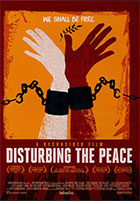
Disturbing the Peace 2016
Distributed by Bullfrog Films, PO Box 149, Oley, PA 19547; 800-543-FROG (3764)
Produced by Stephen Apkon, Andrew Young
Directed by Stephen Apkon
DVD , color, 86 min., English, Arabic and Hebrew with English subtitles
High School - General Adult
Activism, Anthropology, Diversity, History, Jews, Middle East, Peace, Political Science, Social Movements, Sociology, War
Date Entered: 04/19/2018
Reviewed by Linda Kelly Alkana, Department of History, California State University Long BeachThis outstanding film documents how former enemy combatants—Palestinian fighters and Israeli soldiers—join together in an attempt to stop the cycle of violence they inherited, participated in and can no longer support.
The first half of the film gives equal weight to the personal testimonies of many of these activists, generally accompanied by historical footage. Calling themselves, Combatants for Peace, the activists describe their personal connections to the historical horrors of the Holocaust for the Israelis and the Catastrophe for the Palestinians. They then alternate telling parallel stories of trauma (death of relatives), identification and action (with the Israeli Defense Forces or with the opposition to the Occupation), and personal enlightenment, when the individual fighters from both sides realized that they could no longer support the bloodshed.
After the Palestinians reach out to the Israeli Army veterans who had organized to oppose fighting to enforce the occupation, their mutual fear and distrust of “the other” is palpable. They realize soon that the thing they have in common is “their willingness to kill people they didn’t know.” This realization is accompanied by their shared desire for peace, an understanding that all have suffered, and an awareness that they can now look at the conflict from the other’s point of view.
The film then documents how these new peace activists get to know each other through discussions, theatre and non-violent protest. This review does not do justice to the visual impact of the film. All stories are accompanied by well integrated visual footage from the personal accounts, reenactments, television reportage of suicide and military air bombings, documentary coverage of demonstrations, images of blindfolded Palestinians being taken to prison (the Palestinian Combatants had all served time in prison) and on-site pictures of prison life.
The film presents the point of view of the Combatants for Peace and contrasts only briefly, and without comment, the crowded conditions of the Palestinian camps with the modern Israeli cities. The movie emphasizes, instead, the shared pain and hatred that equalizes the Israeli/Palestinian experience. Both the content and the production of this film make Combatants for Peace an important film on the topic.
-
Awards
- Winner, Best Documentary, Big Muddy Film Festival, 2017
- Winner, Humanitarian Award, Ebertfest, 2016
- Winner, Brizzolara Family Foundation Award for a Film of Conflict and Resolution, Hamptons International Film Festival, 2016
- Winner, Audience Award, Traverse City Film Festival, 2016
- Winner, Founders Prize, Traverse City Film Festival, 2016